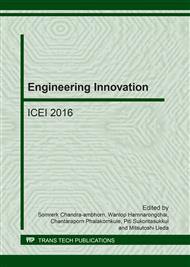[1]
A. Espert, F. Vilaplana, S. Karlsson, Comparison of water absorption in natural cellulosic fibres from wood one year crops in polypropylene composites and its influence on their mechanical properties, Compos Part A – Appl Sci Manuf. 35 (2004).
DOI: 10.1016/j.compositesa.2004.04.004
Google Scholar
[2]
R. Chandra R., R. Rustgi, Biodegradable Polymers, Progress in Polymer Science 23 (1998) 1273-1335.
Google Scholar
[3]
C. Girisha, Sanjeevamurthy, Gunti Rangasrinivas, Effect of alkali treatment, fiber loading and hybridization on tensile properties of sisal fiber, banana empty fruit bunch fiber and bamboo fiber reinforced thermoset composites, International Journal of Engineering & Advanced Technology 2 (2012).
Google Scholar
[4]
R. Malkapuram, V. Kumar, S.N. Yuvraj, Recent Development in Natural Fibre Reinforced Polypropylene Composites, Journal of Reinforced Plastics and Composites 28 (2008) 1169-1189.
DOI: 10.1177/0731684407087759
Google Scholar
[5]
P. Wambua, J. Ivens, I. Verpoest, Natural Fibres: Can They Replace Glass in Fibre Reinforced Plastics, Compos Sci Technol 63 (2003) 1259-1264.
DOI: 10.1016/s0266-3538(03)00096-4
Google Scholar
[6]
M. Wollerdorfer, H. Bader, Influence of natural fibre on the mechanical properties of biodegradable polymer, Industrial crops and products 8 (1998) 105-112.
DOI: 10.1016/s0926-6690(97)10015-2
Google Scholar
[7]
X. Li, L.G. Tabil, S. Panigrahi, Chemical treatment of natural fibre for use in natural fibre-reinforced composites: a review, J. Polym. Environ. 15 (2007) 25-33.
DOI: 10.1007/s10924-006-0042-3
Google Scholar
[8]
L. Y. Mwaikambo, N. Tucker, A.J. Clark, Mechanical properties of hemp fibre reinforced euphorbia composites, Macromol Mater Eng 292 (2007) 993-1000.
DOI: 10.1002/mame.200700092
Google Scholar
[9]
D. Ray, B.K. Sarkar, A. K. Rana, N. R. Bose, Effect of alkali treated jute fibres on composite properties, Bull. Mater. Sci. 24 (2001) 129-135.
DOI: 10.1007/bf02710089
Google Scholar
[10]
Valcineide O.A. Tanobe, Thais H.S. Flores-Sahagun, Sandro C. Amico, Graciela I.B. Muniz, K.G. Satyanarayana, Sponge Gourd (Luffa Cylindrica) Reinforced Polyester Composites: Preparation and Properties, Defence Science Journal 64 (2014) 273-280.
DOI: 10.14429/dsj.64.7327
Google Scholar
[11]
U. Z. Haydar, B. MDH, Preparation, structure, and properties of the coir fiber/polypropylene composites, J Compos Mater 48 (2014) 3293-3301.
Google Scholar
[12]
H. M. Mustafa, D. Benjamin, Unsaturated Polyester Resin Reinforced With Chemically Modified Natural Fibre, IOSR Journal of Polymer and Textile Engineering (IOSR-JPTE) 1 (2014) 31-38.
Google Scholar
[13]
S. Ouajai, R. A. Shanks, Composition, structure and thermal degradation of hemp cellulose after chemical treatment, Polym. Degrad. Stab. 89 (2005) 327-335.
DOI: 10.1016/j.polymdegradstab.2005.01.016
Google Scholar
[14]
V. P. Cyras, C. Vallo, J. M. Kenny, A. Vazquez, Effect of chemical treatment on the mechanical properties of starch-based blends reinforced with sisal fibre, J. Compos. Mater. 38 (2004) 1387-1399.
DOI: 10.1177/0021998304042738
Google Scholar
[15]
S. V. Prasad, C. Pavithran, P. K. Rohatgi, Alkali treatment of coir fibres for coir– polyester composites, J. Mater. Sci. 18 (1983) 1443-1454.
DOI: 10.1007/bf01111964
Google Scholar
[16]
M. M. Kabir, H. Wang, K. T. Lau, F. Cardona, Chemical treatments on plant-based natural fibre reinforced polymer composites: An overview, Compos: Part B 43 (2012) 2883-2892.
DOI: 10.1016/j.compositesb.2012.04.053
Google Scholar
[17]
S. Fakirov, D. Bhattacharyya, Handbook of Engineering biopolymers: Homopolymers, Blends and Composites, Munich Hanser Publishers, (2007).
DOI: 10.3139/9783446442504.fm
Google Scholar
[18]
K. S. Suslick, L. A. Crum, Sonochemistry and Sonoluminescence, in Handbook of Acoustics, M. J. Crocker (Eds. ), Wiley-Interscience: New York, 1998, pp.243-253.
Google Scholar
[19]
M. J. John, R. D. Anandjiwala, Recent developments in chemical modification and characterization of natural fibre-reinforced composites, Polym. Compos. 29 (2008) 187-207.
DOI: 10.1002/pc.20461
Google Scholar
[20]
P. V. Joseph, K. Joseph, S. Thomas, C. K. S. Pillai, S. V. Prasad, G. Groeninckx, S. Mariana, The thermal and crystallisation studies of short sisal fibre reinforced polypropylene composites, Compos Part A – Appl Sci Manuf. 34 (2003) 253-266.
DOI: 10.1016/s1359-835x(02)00185-9
Google Scholar


